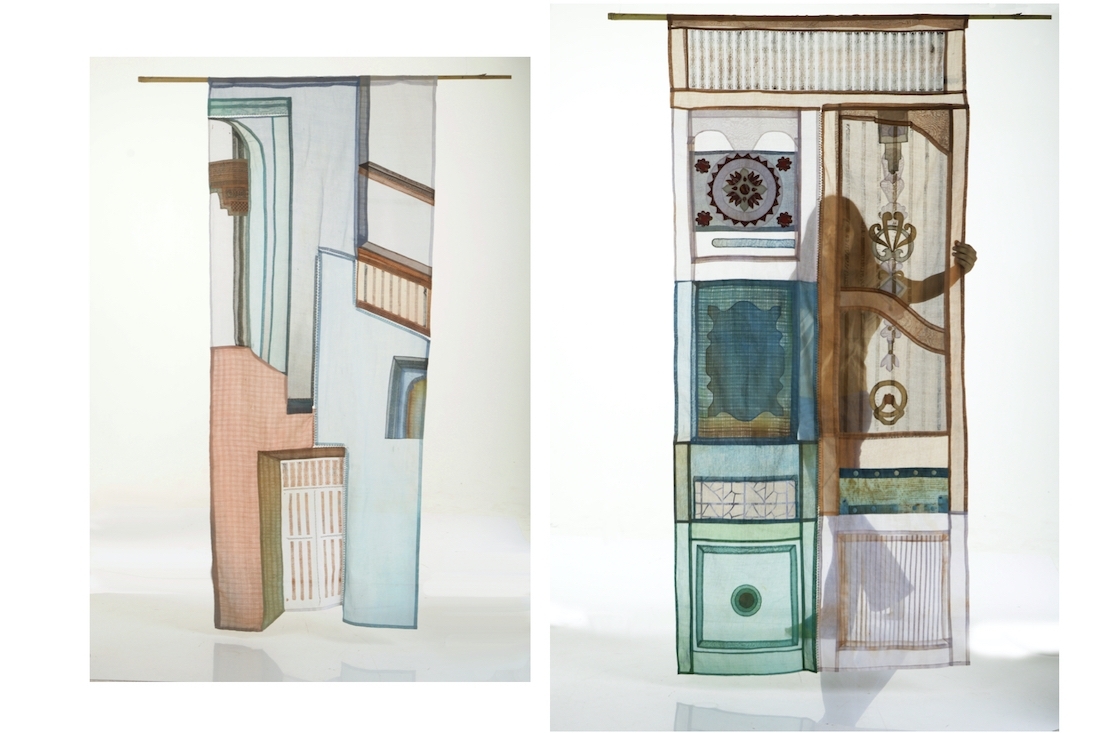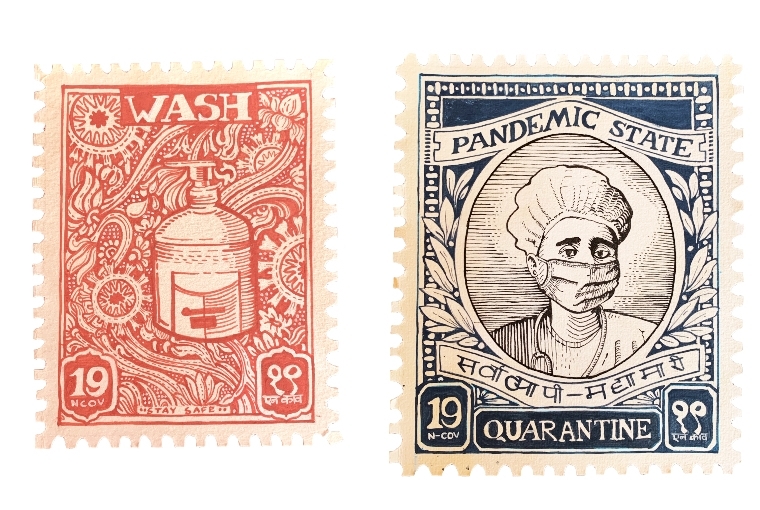
The panels were fabricated using three main techniques of dyeing, sewing with appliqué. Hand embroidery and screen printing were used for detailing.

The panels were fabricated using three main techniques of dyeing, sewing with appliqué. Hand embroidery and screen printing were used for detailing.
Growing up in Jaipur surrounded by the rich heritage of culture and crafts, graphic artist and textile design student Shreya Parasrampuria’s romance with the arts was a given. At an age when children are dreaming of being pilots and scientists, Shreya was honing her skill set. She started learning needle work and embroidery along with other crafts, as early as in the fifth grade. It only helped further that her artistic endeavours were nurtured with love and acceptance by her patient grandmother. One thing led to another and before she knew it, she was building her own board games in school. Adapting western ideas to her milieu, she would use her stickers as tokens. Such creations during her childhood taught her the gravity of the larger lessons of time and context, which also form the basis of what she does now.
Talking about the relevance of art in her life, she adds, ‘I have always felt that drawing is a powerful tool to materialise my thoughts and ideas, whether it be drawing from observation or illustrating. Adapting from the sensitivity to detail in the traditional art forms that I’ve grown around and inculcating the same in my work, but with contemporary themes and other cultures is something that interests me. During my exchange semester at ENSAV, La Cambre in Brussels, I studied flemish tapestries and developed a print project from its rich subjects and iconography.’
Almost every artist is a product of its time — an artist’s sharp gaze inherently captures the suffering and reality a layperson chooses to gloss over. Shreya has always found inspiration in her surroundings, ranging from nature to politics. As a designer, she places utmost importance in the connection between the past and the present. Her artistry seeks inspiration not only from our vibrant culture but also in banal everyday practices. She tells me, ‘This is something that developed when I explored the ubiquitous nature of textiles and how they have remained neglected, almost invisible in the important and broader narrative of human history. There is an urge where I want people to appreciate the simple and small things in life, which we often become oblivious to and take for granted. Busy markets scenes, vendors, old and textured walls, textiles and food I eat are amongst my favourite things to draw.’
The list of artists and artworks in particular, to which she has always been drawn to include Anni Albers, the textile artist and printmaker credited with blurring the lines between traditional craft and art; Reiko Sudo; Issey Miyake, whose works are known for both aesthetic and ‘smart’ properties; Do Ho Suh, a Korean sculptor and installation artist; and Christo and Jeanne Claude’s breathtaking creations.
Shreya has always been fascinated by vintage graphics and Indian stamps, the use of line weights, typography in English and Hindi and decorative border elements. They pushed her creative juices to flow but due to the lack of a relevant subject, she just never implemented her ideas. It was only during the pandemic she was motivated to act on her instincts. She explains, ‘Reading the news about the state of essential workers, it provided me with the perfect subject. Commemorative stamps are issued to honour important events and prominent personalities. I started with the healthcare workers and then police and security services. Our frontline workers deserve all the accolades at this point, I know the list of people is long and the series could continue.’

Shreya’s creative process is intuitive, she finds the most comfort in hand drawing and her go to mediums include watercolours and microns. It always starts with putting the idea on paper, be it for an illustration or a textile design. It aids her in choosing material for the final piece. Her mood boards are an equally vital part of the process, they push her to be an explorer, move out of her comfort zone and play around with different kinds of medium.
Our times are fluid, no one truth is universal, neither is any one methodology sacrosanct. Different mediums often feed off of each other, which can be seen in Shreya’s practice. She doesn’t view textile design and graphic design as separate from one another, rather she was taught in design school that they’re essentially the same, only differentiated by their medium and materials. Talking about how the two coincide for her, she elucidates,‘Textiles are immensely visual and flexible in terms of material. I am fascinated by textural landscapes and subjects, and tend to interpret them using photography, print and embroidery. I am experimenting with hand embroidery on paper illustrations and photographs (transferred on fabric). It provides for a visual and tactile experience, and effortlessly adds a dimension to an otherwise 2D surface, thus engaging our sense of touch.’

R:Watercolour, inks and embroidery on paper. Illustration from a photograph by Artsi Mous.
The pandemic has caused immense pain and suffering world over. It's the kind of adversity that might be collective in nature, yet every individual is facing tribulations that are truly their own. During a catastrophe like the one we’re facing, language might fall short of articulating human agony, however art and design emerge as tools capable of absorbing this pain and helping reflect it. Explaining how design can aid during this time, Shreya adds, ‘Serious creative investigation into cultural, political, social and environmental issues is where design can have a wholesome impact, rather than limiting it to capitalist and commercial applications. The advanced times we live in today are credited to human ingenuity, at the same time we pose a threat to the ecosystem. The pandemic has given us time to mull over these aspects and be mindful of our actions. I believe that the ability to communicate and form alliances is one of the strongest assets of design, and with the qualification of being a designer, one can make genuine contributions to the community.’

Shreya Parasrampuria
Text Unnati Saini